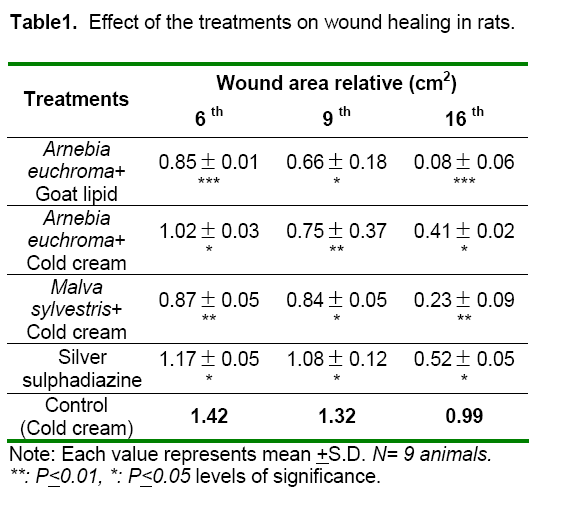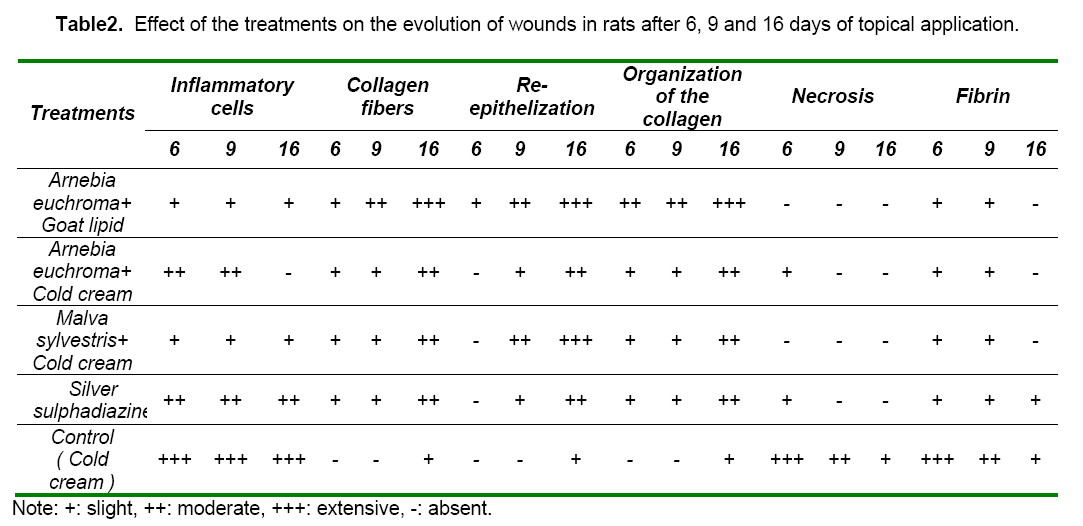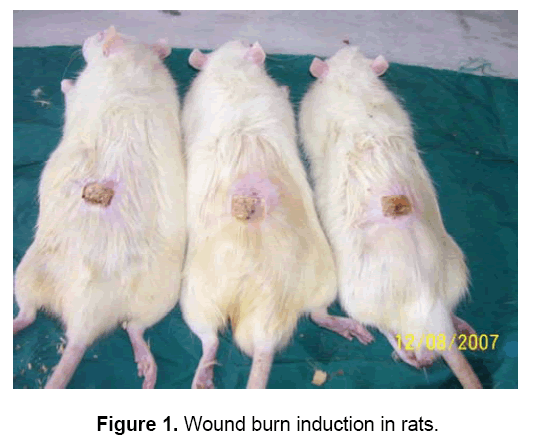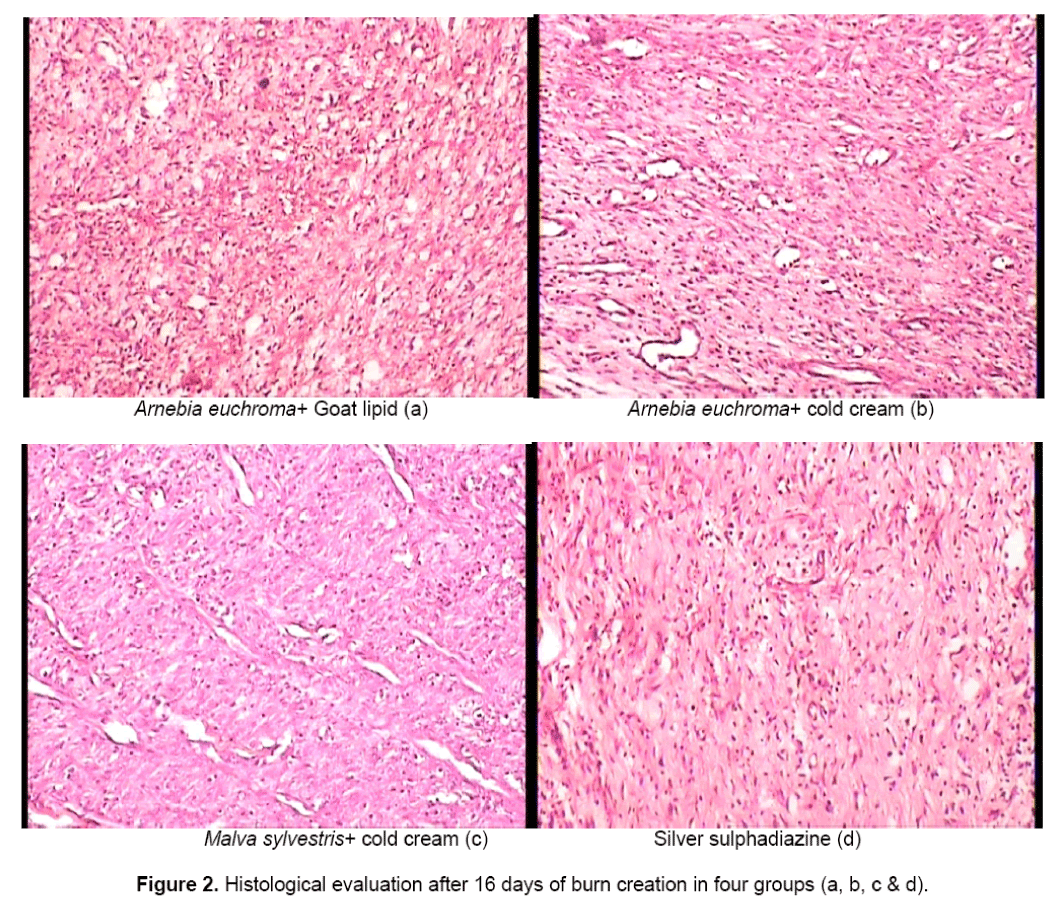Evaluation of Burn Healing Properties of Arnebia euchroma and Malva sylvestris
Abdollah Ghasemi Pirbalouti, Mehdi Yousefi, Heshmatollah Nazari2, Iraj Karimi, Abed Koohpayeh
Abdollah Ghasemi Pirbalouti1*,Mehdi Yousefi2,Heshmatollah Nazari2,Iraj Karimi3,Abed Koohpayeh1
1Researches Centre of Medicinal Plants & Ethnoveterinary,Islamic Azad University of Shahrekord Branch,Shahrekord,Iran,POBox:166
2Department of Plant Sciences,Payam Noor University of Isfahan,Isfahan,Iran
3Department of Pathology,Veterinary Medicine Faculty,Shahrekord University,Shahrekord,Iran
- Corresponding Author:
- Abdollah Ghasemi Pirbalouti
Tel: +98(0)381-3361070
Fax: +98(0)381-3361060
E-mail: ghasemi955@yahoo.com
Abstract
Arnebia euchroma Rolye (Johnst) (Boraginaceae) and Malva sylvestris L. (Malvaceae) are traditionally used to treat various skin disorders, and for antimicrobial, and anti-inflammatory activities. The goat lipid containing roots of Arnebia euchroma is widely used as a remedy for burn wounds in nomadic tribal (Bakhtyari) southwest Iran. We examined the effectiveness of diethyl ether extracts of Arnebia euchroma roots and Malva sylvestris flowers at 200 mg/kg/day dose. Burns were induced in Wistar rats divided into six groups as following; Group-I was treated with cold cream. Groups-II and -III were treated with cold cream containing of two extracts, Group-IV was treated with goat lipid containing of Arnebia euchroma extract (according ethnobotany survey). Group-V was treated with goat lipid. Group-VI received the standard drug (silver sulphadiazine cream). The efficacy of treatment was evaluated based on reduction of burn wound area and histopathological characteristics. The extracts-treated animals showed significant reduction (P < 0.05) in the wound area when compared with other groups. Also, histological studies of the tissue obtained on days 6, 9 and 16 from the extract-treated by goat lipid containing of Arnebia euchroma and Malva sylvestris showed increased well organized bands of collagen, more fibroblasts, and few inflammatory cells. So we concluded that Arnebia euchroma and Malva sylvestris in the form of ointment had a good potential for acceleration of burn wound healing in rats.
Keywords
Burn; medicinal plants; Arnebia euchroma; Malva sylvestris.
1. Introduction
Burn wounds are very common in both developed and developing countries,however,in developing countries burns constitute a major health problem because the incidence of severe complications is high,and financial resources are limited. Burn wound healing is a complex process that does not require much help,but still causes discomfort,and wounds are prone to infection and other complications. Infection is a major complication of burn injury and is responsible for 50-75% of hospital deaths [11]. Many of the synthetic drugs pose problems such as allergy,drug resistance,etc.,forcing scientists to seek alternative drugs [15]. More than 80% of the world’s population depends upon traditional medicines for various skin diseases [2]. Recently,the traditional use of plants for wound healing has received attention by the scientific community [2,8]. Approximately one-third of all traditional medicines in use are for the treatment of wounds and skin disorders,compared to only 1-3% of modern drugs [10].
Several plants used as traditional healing remedies have been reported to treat skin disorders,including burn and cut wounds. In Iran,a survey of the ethnobotanical studies indicated the use of several of plant species by the inhabitants of the area,especially by those habiting the rural areas for wounds healing purpose [6,7,22]. For example,nomadic tribal (Bakhtyari) in southwest Iran,the roots of Arnebia euchroma with goat lipid used as a remedy for burn wounds [6].
Arnebia euchroma Rolye. (Johnst.) (Boraginaceae),a well-known traditional herb used in tribal medicine of Iran,is locally known as “Sorkh Giyah or Heveh Choaeh”. Shikonin derivatives isolated from the roots of Arnebia euchroma have been reported to have antimicrobial,anti-inflammatory and anti-tumour activities and thus to be considered as important compounds for potentially medicinal use [9].
Malva sylvestris Linn. (Malvaceae),known locally as “Panirak”,is an important medicinal plants in Iran whose flowers are used as a remedy for cut wound,eczema,dermal infected wounds,bronchitis,digestive problems and inflammatory in Unani medicinal (Iranian Traditional Medicine) literatures [7,22]. A new anthocyanin,malvidin 3-(6″-malonylglucoside)-5-glucoside has been characterized in both wild and cultivated forms of Malva sylvestris [20]. The malvone A (2-methyl-3-methoxy-5,6-dihydroxy-1,4-naphthoquinone) is reported [4,21].
No systematic studies have yet been carried out on the clinical evaluation of the burn wound healing potency of Malva sylvestris and Arnebia euchroma,so these effects were investigated using excision,histopathological characteristics and dead space wound repair models in rats.
2. Materials and Methods
Plant materials
The flowers of Malva sylvestris were collected on the slopes of the Zagross Mountains (1700–1800 m),District of Chaharmahal and Bakhtiari,Iran,during May 2007. The roots of Arnebia euchroma collected from the Jahanbin Mountain,Shahrekord,Iran in August 2007. Dr Valiollah Mozaffarian,Researches Institute of Forests and Rangeland,Tehran,Iran,authenticated the plants.
Preparation of the extract
About 100 g of powdered roots of Arnebia euchroma and flowers of Malva sylvestris were extracted with absolute 75% diethyl ether (Merck®) using Soxhlet apparatus for 12 h. The extracts filtered on Whatman paper and lyophilized a residue (yield: 10% w/w).
Animals
Male Wistar rats (200-250 g) of 2-3 months were used. The animals were housed in standard environmental conditions of temperature (22 ±3ºC),humidity (60 ±5%) and a 12 h light/dark cycle. During experimental time rats were given standard pellet diet (Pastor Institute,Iran) and water ad libitum.
Burn wound creation
Burn wounds were created on dorsal part of shaved rats using a metal rod (1.5 cm diameter) heated to 80-85°C and exposed for 20s [18]. After 24 h,dead tissues were excised using sterile surgical blade (Figure 1). Control rats were dressed with cold cream alone,while experimental rats were dressed with the 10% (w/w) ointment formulated.
Experimental design
The animals were divided randomly into six groups of nine each. Group-I was treated with cold cream. Groups-II and -III were treated with cold cream containing of two extracts (200 mg/kg/day),Group-IV was treated with goat lipid containing of Arnebia euchroma extract (200 mg/kg/day) (according ethnobotany survey). Group-V was treated with goat lipid. Group-VI received the standard drug (silver sulphadiazine cream) (200 mg/kg/day).
Burn healing
During the burn wound healing period and at the present time intervals,the burn wound area was traced manually and photographed. The burn wound area was calculated using Auto CAD RL 14 (Autodesk Company) software. At days 6th,9th and 16th the experiment was terminated and the wound area was removed from the surviving animals for histologicsal examination. The excision skin biopsies were fixed in 4% formaldehyde solution 48 h during the experimentation period.
Analysis of data
The relative burn wound area was statistically analyzed as mean + S.D and statistically significance between treated and control groups were analyzed by means of Student’s t-test. Data are significant; P-values ≤ 0.05 compared with control by the program “SAS ver 6.12 full”.
3. Results
The efficacy of treatment was evaluated based on reduction of burn wound area and histopathological characteristics. The extracts-treated animals showed significant reduction (p < 0.05) in the wound area when compared with other groups. The animals treated with goat lipid containing of Arnebia euchroma extract (according ethnobotany survey) showed a significant reduction in the wound area when compared with other groups (Table 1). The animals treated with goat lipid containing of Arnebia euchroma extract showed faster epithelialization than those treated with the standard drug and other extracts (Table 2). Sorry,four animals treated with goat lipid deceased by high infection in wound.


The best results of histhopatologial evaluation were obtained with goat lipid containing of Arnebia euchroma extract and following Malva sylvestris extract,when compared to the other groups as well as to the control and the standard drug (Table 2 & Figure 2 ). These results offer pharmacological evidence on the folkloric use of Arnebia euchroma and Malva sylvestris for burn healing. The study of the histological structure showed the tissue regeneration was grater in the skin wound treated with goat lipid containing of Arnebia euchroma extract (Table 2 & Figure 2 ). The animal treated with cold cream (control) presented edema,monocyte cells and area with cellular necrosis that were not observed in the treated with herbal ointments and standard drug (Table 2 & Figure 2 ).
4. Discussions and Conclusions
Burn and wound healing is a process by which damaged tissue is restored as closely as possible to its normal state and wound contraction is the process of shrinkage of the area of the wound. It is mainly dependent upon the type and extent of damage,the general state of health and the ability of the tissue to repair [3]. The wound contraction was significantly faster and higher in percentage in animals treated with goat lipid containing extracts of Arnebia euchroma roots and cold cream containing extracts of Malva sylvestris (Table 1). Finally,the epithelialization time was also found to be shorter in animals treated with goat lipid containing Arnebia euchroma (Table 1). In our study extracts significantly increased the rate of wound contraction and collagen turnover. Collagen,the major component which strengthens and supports extracellular tissue [17].
The roots of some genera of the Boraginaceae family such as Arnebia,Alkanna,Onosma,Lithospermum and Echium species are rich in naphthoquinones. alkannin,shikonin and their derivatives. Alkannin esters showed excellent healing properties in a clinical study conducted on 72 patients suffering from indolent ulcer on the lower part of the leg,due to varicose veins [14]. Accelerative effect of an ether extract of two Boraginaceae species Lithospermum erythrorhizon roots and Macrotomia euchroma roots on the proliferation of granuloma tissue in rats has been demonstrated [12,13]. They suggested that the accelerative effect of the roots on the proliferation of granuloma tissue depended mostly on the total content of naphthoquinone derivatives and the accelerative effect induced by ether extract might be an additive effect of these naphthoquinone derivatives. According previous studied [19] related that naphthoquinone derivative,arnebin-1 (b,b-dimethylacrylalkannin),significantly accelerated wound healing with or without hydrocortisone treatment [19]. Akkol et al. (2009) showed that,the treatment with arnebin-1 showed reduction in the wound width and gap length compared with controls,moreover,promoted cell proliferation,migration and vessel formation to form a thick granulation tissue and re-epithelization of the wounds. Shikonin derivatives isolated from the roots of Arnebia euchroma have been reported by Kim et al. (2001) reduced to shikonin semiquinone radical by O2 and these scavenging activities may play an important role in the wound healing enhancement of the plant extract [16].
Any one of the phytochemical constituents (malvone A: 2-methyl-3-methoxy-5,6-dihydroxy-1,4-naphthoquinone) present in Malva sylvestris may be responsible for antimicrobial activity [5]. It may be either due to the individual or additive effect of the phyto-constituents that hastens the process of wound healing.
The result of the present study offers pharmacological evidence on the folkloric use of Arnebia euchroma roots with goat lipid for healing wounds. Hence,the results support the traditional use of Arnebia euchroma roots to treat skin disorders including burns.
Acknowledgements
This work was supported by IAUSHK (Researches Affairs). The authors are thankful to Mr. F. Fadi Fard,Ph.D and Mr. M. Farid,Ph.D (Surgical) for their technical support.
References
- Akkol E.K.,Koca U.,Pes I.¸ YÃÆââ¬Å¾Ãâñlmazer D.,Toker G.,Yesilada E. (2009) Exploring the Wound Healing Activity of Arnebia densiflora (Nordm.) Ledeb. by in vivo models. Journal of Ethnopharmacology,124: 137-141.
- Annan K.,Houghton P.J. (2007) Antibacterial,antioxidant and fibroblast growth stimulation of aqueous extracts of Ficus asperifolia Miq. and Gossypium arboreum L.,wound-healing plants of Ghana. Journal of Ethnopharmacology,119: 141-144.
- Anuar N.S.,Zahari S.S.,Taib I.A.,Rahman M.T. (2008) Effect of green and ripe Carica papaya epicarp extracts on wound healing and during pregnancy. Food and Chemical Toxicology,46: 2384-2389.
- Cutillo F.,D’Abrosca B.,DellaGreca M.,Fiorentino A.,Zarrelli A. (2006) Terpenoids and phenol derivatives from Malva silvestris. Phytochemistry,67: 481-485.
- D’Amelio,F.S. (1999) Botanicals,a phyto-cosmetic desk reference. CRC Press LLC,Boca Raton,USA.
- Ghasemi Pirbalouti A. (2009) Iranian medicinal and aromatic plants. Islamic Azad University Publishers,Shahrekord,Iran,2nd edition.
- Ghorbani A. (2005) Studies on pharmaceutical ethnobotany in the region of Turkman Sahra,north of Iran. Journal of Ethnopharmacology,102: 58-68
- Houghton P.J.,Hylands P.J.,Mensah A.Y.,Hensel A.,Deters A.M. (2005) In vitro tests and ethnopharmacological investigations: Wound healing as an example. J Ethnopharmacol,100: 100-107.
- Kim S.H.,Kang I.C.,Yoon T.J. (2001) Antitumor activities of a newly synthesized shikonin derivative,2-hyim-DMNQS-33. Cancer Letter,172: 171-175.
- Mantle D.,Gok M.A.,Lennard T.W.J. (2001) Adverse and beneficial effects of plant extracts on skin and skin disorders. Adverse Drug Reaction and Toxicological Reviews,20: 89-103.
- Mokaddas E.,Rotimi V.O.,Sanyal S.C. (1998) In vitro activity of piperacillin / tazobactam versus other broad antibiotics against nosocomial gram negative pathogens isolated from burn patients. Journal of Chemotherapy,10: 208-214.
- Ozaki Y.,Ohno A.,Abe K.,Saito Y.,Satake M. (1993) Comparative study on the accelerative effect of koushikon and nanshikon and their constituents on proliferation of granuloma tissue in rats. Biological and Pharmaceutical Bulletin,16: 683-685.
- Ozaki Y.,Xing L.,Satake M. (1996) Accelerative effect of nanshikon and its constituents on the proliferation of granulation tissue in rats. Biological and Pharmaceutical Bulletin,19: 233-236.
- Papageorgiou V.P. (1978) Wound healing properties of naphtaquinone pigments from Alkanna tinctoria. Experientia,34: 1499-1501.
- Purna S.K.,Babu M. (1998) Traditional medicine and practices in burn care: need for newer scientific perspectives. Burns,24: 387-388.
- Sekine T.,Masumizu T.,Maitani Y.,Nagai T. (1998) Evaluation of superoxide anion radical scavenging activity of shikonin by electron spin resonance. Inter J Pharmaceutics,174: 133-139.
- Senthil-Kumar M.,Kirubanandan S.,Sripriya R.,Kumar Sehgal P. (2006) Triphala promotes healing of infected full-thickness dermal wound. Journal Surgical Research,144: 94-101.
- Shanmuga Priya K.S.,Gnanamani A.,Radhakrishnan N.,Babu M. (2002) Healing potential of Datura alba on burn wounds in albino rats. Journal of Ethnopharmacol,83: 193-199.
- Sidhu G.S.,Singh A.K.,Banaudha K.K.,Gaddipati J.P.,Patnaik G.K.,Maheshwari R.K. (1999) Arnebin-1 accelerates normal and hydrocortisone-induced impaired wound healing. The Journal for Investigative Dermatolology,113: 773-781.
- Takeda K.,Enoki S.,Harborne J.B.,Eagles J. (1989) Malonated anthocyanins in Malvaceae: Malonylmalvin from Malva sylvestris. Phytochemistry,28: 499-500.
- Veshkurova O.,Golubenko Z.,Pshenichnov E.,Arzanova I.,Uzbekov V.,Sultanova E.,Salikhov S.,Williams H.J.,Reibenspies J.H.,Puckhaber L.S.,Stipanovic R.D. (2006) Malvone A,a phytoalexin found in Malva sylvestris (family Malvaceae). Phytochemistry,67: 2376-2379.
- Zargari A. (1990) Medicinal Plants. Tehran University Publishers,Tehran,Iran. 4th edition.

Open Access Journals
- Aquaculture & Veterinary Science
- Chemistry & Chemical Sciences
- Clinical Sciences
- Engineering
- General Science
- Genetics & Molecular Biology
- Health Care & Nursing
- Immunology & Microbiology
- Materials Science
- Mathematics & Physics
- Medical Sciences
- Neurology & Psychiatry
- Oncology & Cancer Science
- Pharmaceutical Sciences


